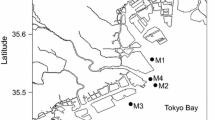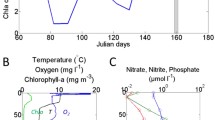Abstract
Large amorphous particles (Nuta) observed in coastal areas after phytoplankton blooms and red tide outbreaks were collected by Nuta traps. These particles are always thickly attached to mooring ropes and/or fishing nets. From the decomposition experiments of Nuta and the sinking particles, dissolved inorganic nitrogen (DIN) and dissolved inorganic phosphorus (DIP) regenerations were active in Nuta, but were not active in sinking particles. In Nuta, regeneration abundances during 10 days were 567 μg-N/mg of initial particulate organic nitrogen (PON), and 583 μ-P/mg of initial particulate phosphorus (PP), respectively. Thus DIP was more regenerated from Nuta than DIN. Ten days integral regeneration abundances of DIN and DIP from Nuta were estimated to be 36% and 79% of in situ DIN and DIP standing stocks, respectively. Nuta contributes an important role of nutrient regeneration particularly DIN, in coastal water. Carbon and nitrogen stable isotope ratios of suspended particles, sinking particles and Nuta indicated that these three different type of particles were almost the same origin, and thus Nuta in the coastal water should be made from phytoplankton debris.
Similar content being viewed by others
References
Alldredge, A. L. (1976): Discarded appendicularation houses as sources of food, surface habitats and particulate organic matter in planktonic environments.Limnol. Oceanogr.,21, 14–23.
Alldredge, A. L. and J. L. Cox (1982): Primary production and chemical composition of marine snow in surface waters Southern California Bight.J. Mar. Res.,40, 517–527.
Alldredge, A. L. and M. W. Silver (1988): Characteristics, dynamics and significance of marine snow.Prog. Oceanogr.,20, 41–82.
Altabet, M. A. (1988): A time-series study of the vertical structure of nitrogen and particle dynamics in the Sargasso Sea.Limnol. Oceanogr.,34, 1185–1201.
Beers, J. R., J. D. Trent, F. M. H. Reid and A. L. Shanks (1986): Macroaggregates and their phytoplankton composition in the Southern California Bight.J. Plantton. Res.,8, 475–487.
Cifuentes, L. A., J. H. Sharp and M. L. Forgel (1988): Stable carbon and nitrogen isotope biogeochemistry in the Deleware estuary.Limnol. Oceanogr.,33, 1102–1115.
Johnson, B. D. and R. C. Cooke (1980): Organic aggregate formation resulting from distribution of bubbles in sea water.Limnol. Oceanogr.,25, 653–661.
Minagawa, M. and E. Wada (1985): Biogeochemical implication of H, C, N, O stable isotope composition in plant and animal.Chikyu-kagaku,19, 39–52.
Mishima, Y., S. Montani and T. Okaichi (1990a): The nature and distribution of large amorphous particles (NUTA) in Osaka Bay, Japan.Geochem. J.,24, 197–206.
Mishima, Y., S. Montani and T. Okaichi (1990b): Large amorphous particles (Nuta): The development of the sampling system and comparison with suspended and sinking particles.La mer.,28, 123–130.
Montani, S., K. Tada and T. Okaichi (1988): Purine and pyrimidine bases in marine particles in the Seto Inland Sea, Japan.Mar. Chem.,25, 359–371.
Montani, S., Y. Mishima and T. Okaichi (1991a): Some characteristic features of large amorphous aggregates (Nuta) in the Seto Inland Sea, Japan.J. Oceanogr. Soc. Japan,47, 276–285.
Montani, S., Y. Mishima and T. Okaichi (1991b): Scavenging processes of marine particles in Osaka Bay.Mar. Pollut. Bull.,23, 107–111.
Ogura, N., K. Kimura, T. Sekigawa, K. Yamada and M. Minagawa (1986): Stable isotope ratios of particulate organic carbon in surface water at inner part of Tokyo Bay.Chikyu-kagaku,20, 13–19.
Paerl, H. W. (1973): Detritus in Lake Tahoe: Structural modification by attached microflora.Science,180, 496–498.
Paerl, H. W. (1974): Bacterial uptake of dissolved organic matter in relation to detrital aggregation in marine and fresh water system.Limnol. Oceanogr.,21, 966–972.
Parsons, T. R., Y. Maita and C. M. Lalli (1984a):A Manual of Chemical and Biological Methods for Sea Water Analysis. Pergamon Press, New York.
Pomeroy, E. R. and D. Deibel (1980): Aggregation of organic matter by pelagic tunicates.Limnol. Oceanogr.,25, 643–652.
Seiki, T., E. Date and H. Izawa (1991): Decomposition characteristics of particulate organic matter in Hiroshima Bay.J. Oceanogr. Soc. Japan,47, 207–220.
Shanks, A. L. and J. D. Trent (1979): Marine snow: Microscale nutrient patches.Limnol. Oceanogr. 24, 850–854.
Shanks, A. L. and J. D. Trent (1980): Marine snow: sinking rates and potential role in vertical flux.Deep-Sea Res.,27, 137–143.
Silver, M. W., A. L. Shanks and J. D. Trent (1978): Marine snow: microplankton habbitat and source of small-scale pachiness in pelagic populations.Science,201, 371–373.
Trent, J. D., A. L. Shanks and M. W. Silver (1978): In situ and laboratory measurements on macroscopic aggregates in Monterey Bay, California.Limnol. Oceanogr.,23, 626–635.
Tujita, T. (1952): A preliminary study on naturally occurring suspended matter in waters adjacent to Japan.J. Oceanogr. Soc. Japan,8, 113–126.
Author information
Authors and Affiliations
Rights and permissions
About this article
Cite this article
Montani, S., Mishima, Y. The role of Nuta (large amorphous particles) as a nutrient regenerator in Osaka Bay. J Oceanogr 49, 285–293 (1993). https://doi.org/10.1007/BF02269566
Received:
Revised:
Accepted:
Issue Date:
DOI: https://doi.org/10.1007/BF02269566




